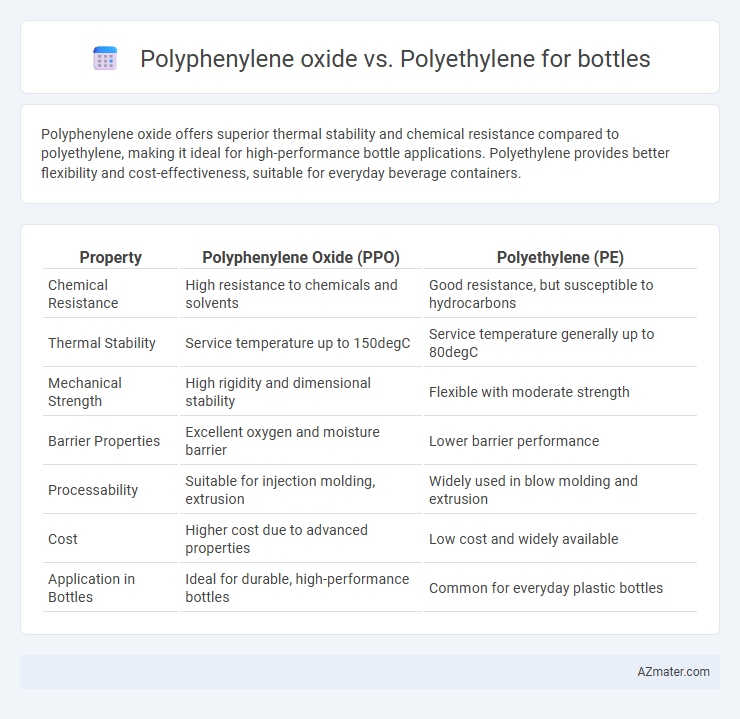Polyphenylene oxide offers superior thermal stability and chemical resistance compared to polyethylene, making it ideal for high-performance bottle applications. Polyethylene provides better flexibility and cost-effectiveness, suitable for everyday beverage containers.
Table of Comparison
| Property | Polyphenylene Oxide (PPO) | Polyethylene (PE) |
|---|---|---|
| Chemical Resistance | High resistance to chemicals and solvents | Good resistance, but susceptible to hydrocarbons |
| Thermal Stability | Service temperature up to 150degC | Service temperature generally up to 80degC |
| Mechanical Strength | High rigidity and dimensional stability | Flexible with moderate strength |
| Barrier Properties | Excellent oxygen and moisture barrier | Lower barrier performance |
| Processability | Suitable for injection molding, extrusion | Widely used in blow molding and extrusion |
| Cost | Higher cost due to advanced properties | Low cost and widely available |
| Application in Bottles | Ideal for durable, high-performance bottles | Common for everyday plastic bottles |
Introduction: Polyphenylene Oxide vs Polyethylene for Bottles
Polyphenylene oxide (PPO) and polyethylene (PE) are key polymers used in the manufacturing of bottles, each offering distinct properties suitable for various applications. PPO provides superior thermal stability and excellent chemical resistance, making it ideal for high-performance bottle containers requiring durability at elevated temperatures. Polyethylene, especially high-density polyethylene (HDPE), is favored for its flexibility, impact resistance, and cost-effectiveness in everyday beverage and household product bottles.
Chemical Structure and Composition
Polyphenylene oxide (PPO) consists of aromatic rings linked by oxygen atoms, offering high thermal stability and chemical resistance, making it ideal for durable bottle applications. Polyethylene (PE) features a simple linear or branched hydrocarbon chain composed of repeated ethylene units, ensuring flexibility and moisture resistance but lower temperature tolerance. The rigid and oxygen-containing backbone of PPO contrasts with the saturated hydrocarbon structure of PE, influencing their mechanical properties and environmental resilience in bottle manufacturing.
Mechanical Strength and Durability
Polyphenylene oxide (PPO) exhibits superior mechanical strength and durability compared to polyethylene, making it ideal for high-performance bottle applications requiring resistance to impact and deformation. PPO offers excellent thermal stability and maintains its mechanical properties under prolonged use and exposure to harsh conditions, outperforming polyethylene's tendency to soften at lower temperatures. Polyethylene, while cost-effective and flexible, generally provides lower tensile strength and is more prone to wear and environmental stress cracking than PPO.
Barrier Properties: Oxygen and Moisture Resistance
Polyphenylene oxide (PPO) exhibits superior barrier properties compared to polyethylene (PE), providing enhanced oxygen and moisture resistance essential for bottle applications requiring prolonged product freshness. PPO's dense molecular structure significantly limits oxygen permeability, reducing oxidative spoilage, while its hydrophobic characteristics minimize moisture transmission. In contrast, polyethylene's higher oxygen and water vapor transmission rates make it less effective for packaging sensitive products where barrier integrity is critical.
Thermal Stability and Temperature Tolerance
Polyphenylene oxide (PPO) exhibits superior thermal stability compared to polyethylene (PE), maintaining structural integrity at temperatures up to 200degC, while polyethylene typically softens around 105degC. This enhanced temperature tolerance makes PPO ideal for bottles requiring repeated sterilization or heat exposure without deformation. In contrast, polyethylene's lower melting point limits its use in high-temperature applications but offers greater flexibility and cost efficiency for everyday beverage containers.
Chemical Resistance and Compatibility
Polyphenylene oxide (PPO) exhibits superior chemical resistance compared to polyethylene (PE), with excellent stability against solvents, acids, and alkalis, making it ideal for bottles storing aggressive chemicals. Polyethylene offers good compatibility with a wide range of substances but tends to swell or degrade when exposed to strong chemicals like aromatics or chlorinated solvents. PPO's inherent thermal and dimensional stability further enhances compatibility for long-term chemical storage in bottle applications.
Manufacturing Processes and Moldability
Polyphenylene oxide (PPO) offers superior thermal stability and dimensional accuracy during injection molding compared to polyethylene (PE), making it ideal for precision bottle manufacturing. The high glass transition temperature of PPO allows more consistent moldability with less shrinkage, enhancing detail retention and durability in bottle designs. Polyethylene, favored for its flexibility and ease of processing via blow molding, provides cost-effective mass production but with lower heat resistance and mechanical strength than PPO.
Environmental Impact and Recyclability
Polyphenylene oxide (PPO) offers superior thermal stability and inherent flame resistance compared to polyethylene (PE), making it favorable for high-performance bottle applications. In terms of environmental impact, PPO is more durable and resists chemical degradation, but its recyclability is limited due to specialized processing requirements. Polyethylene, especially high-density polyethylene (HDPE), is widely recyclable with established infrastructure, contributing to lower overall environmental impact through efficient closed-loop recycling systems.
Cost Comparison and Market Availability
Polyphenylene oxide (PPO) offers superior thermal stability and chemical resistance compared to polyethylene (PE), but its higher production cost significantly impacts bottle manufacturing expenses. Polyethylene dominates the market due to its low cost, wide availability, and ease of processing, making it the preferred material for mass-produced bottles. Market data indicates that while PPO bottles are niche and priced 2-3 times higher than PE alternatives, PE maintains over 80% share in the global bottle market due to cost-effectiveness and supply chain maturity.
Applications and Suitability in Bottle Production
Polyphenylene oxide (PPO) offers excellent thermal stability and chemical resistance, making it ideal for high-performance bottle applications such as automotive and medical containers that require durability under harsh conditions. Polyethylene (PE), particularly high-density polyethylene (HDPE), is favored for general beverage and household product bottles due to its flexibility, impact resistance, and cost-effectiveness. While PPO is suited for specialized, high-end bottles requiring advanced properties, polyethylene dominates the mass market with versatility and ease of processing for food-grade and everyday liquid containers.

Infographic: Polyphenylene oxide vs Polyethylene for Bottle
 azmater.com
azmater.com